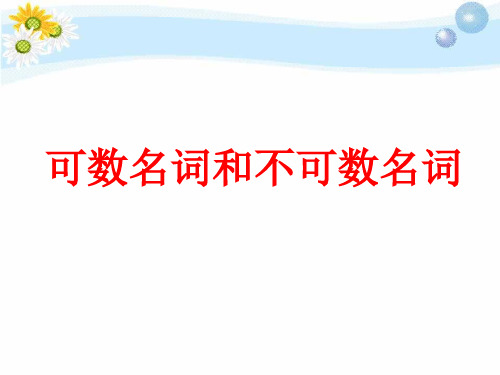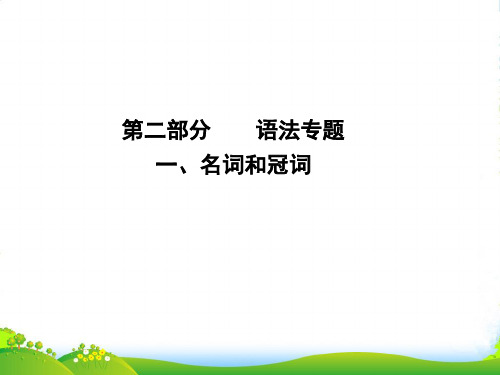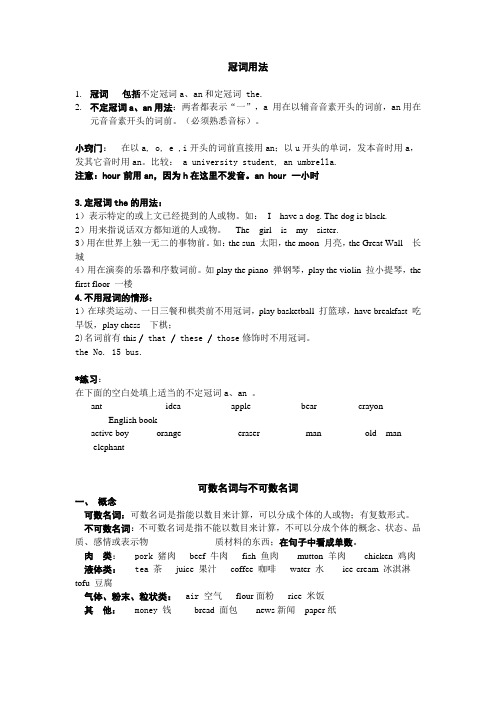lesson2 不可数名词、冠词、there be
- 格式:doc
- 大小:54.04 KB
- 文档页数:4



1至6年级不可数名词和单复数同形的单词语一、可数名词与不可数名词的区别普通名词所表示的人或事物是可以按个数计算的,这类名词叫可数名词。
可数名词分为个体名词(表示某类人或事物中的个体,如worker, farmer, desk, factory等)和集体名词(表示作为一个整体来看的一群人或一些事物,如people,family 等)。
如果普通名词所表示的事物是不能按个数来计算的,这类名词就叫不可数名词。
不可数名词分为物质名词(表示无法分为个体的物质,如meat, rice, water, milk, orange 等)和抽象名词(表示动作、状态、情况、品质等抽象概念,如work, homework, time, health, friendship等)。
二、关于可数名词可数名词有单数和复数两种形式。
指一个人或一件事物时,用单数形式;指两个或多个人或事物时用复数形式。
名词由单数形式变成复数形式的规则如下:1. 一般的名词词尾直接加-s 。
如:book → books room → roomshouse → houses day → days2. 以s,ss, ch,sh, x 结尾的名词,在词尾加-es 。
如:bus → buses glass → glasseswatch → watchesdish → dishes box → boxes3. 以"辅音字母+y"结尾的名词,要先将y改为i再加-es。
如:city → cities body → bodiesfactory → factories等等。
4. 以f 或fe 结尾的名词,要将f或fe改为v再加-es。
如:half → halves leaf → le avesknife → knives wife → wives5. 特例[悄悄话:特例常常考,要记住。
]① child → children② man → men woman → womenpoliceman → policemen(规律:man → men)③ tomato → tomatoespotato → potatoes[悄悄话:初中英语以o 结尾的名词变复数时只有这两个词加-es,其余的当然加-s喽!如:photo → photos ]④ foot → feet tooth → teeth[悄悄话:oo变成ee。

不可数名词归类及用法名词是用来表示人、事物和抽象概念的词语。
它们可以分为可数名词和不可数名词。
可数名词可以有单数和复数形式,例如:一个包,两个包。
而不可数名词通常没有复数形式,不能在词尾加s或es变成复数。
我们学过的不可数名词有许多,例如:冰、雨、雪、风、面包、肉、果汁、糖、食物、米饭、水、咖啡、茶、牛奶、果酱、巧克力、水果、纸、头发等,这些物质名词都是不可数名词。
此外,抽象名词如工作、帮助、爱、希望、天气等也是不可数名词。
在使用不可数名词时,需要注意以下几点:1.不可数名词前面不能直接加a / an,例如:I like to skate on an ice。
(×)I like to skate on the ice。
(√) 我喜欢在冰上溜滑。
如果要表示一定的数量,可以借助单位词,例如:一块冰、三杯茶、一碗米饭、一大块巧克力等。
2.不可数名词的词尾不能加s或es变成复数。
3.一些词语如some、any、no、a little、much、a lot of等可以修饰不可数名词,例如:I don’t want any help。
我不需要任何帮助。
There’s some milk in t he glass。
玻璃杯里有一些牛奶。
请把下面的句子改正过来:1.请给我一些果汁。
Give me some juices。
please。
(×)Give me some juice。
please.2.我喜欢坐在阳光下。
I like to sit in a sun。
(×)I like to sit in the sun.3.桌子上有两碗米饭。
There are two rices on the table。
(×)There are two bowls of rice on the table.4.他们喜欢在风中玩耍。
They like to play in the wind。
(√)1.The library has many (books) on different subjects。

新概念英语1 B Unit 16一、There be 存在句句型1. 定义:表示某地存在某人/ 某物2. 句型:There is + 单数可数名词/不可数名词+ 某地There are + 可数名词复数+ 某地3. There be句型与have / has 的区别:①have 与has 都表示拥有②There be 表示存在3. 句型转换:否定句:There be + not +主语+ 介词短语一般疑问句:Be +there+主语+介词短语+?肯定回答:---- Yes, there be.否定回答:---- No, there be not.例:陈述句:There are many children in the classroom.否定句:There are not any students in the classroom.一般疑问句:Are there any children in the classroom?肯定回答:Yes, there are.否定回答:No, there are not.4. 就近原则:There be 句型主语在后面,靠近be动词的主语决定be 动词的选择。
例:There is an apple and a banana on the table.There are three chairs and two desks in the classroom.二、名词单复数1. 定义:表示人、事物、时间、地点抽象概念等词。
2. 可数名词单数变复数:①规则变化:一般情况下在词尾+ s/ esA: 以s,x,ch,sh结尾的单词在词尾+ esB: 以辅音字母y结尾的单词,把y 变为i,再加esC: 以f/ fe 结尾的单词,变f / fe 为v,再加esD: 以o结尾,有生命的单词+ es ,无生命的+ s注意:以o结尾,+es 的情况:Negroes and heroes like potatoes and tomatoes. 黑人和英雄喜欢土豆和西红柿。

冠词用法1.冠词包括不定冠词a、an和定冠词 the.2.不定冠词a、an用法:两者都表示“一”,a 用在以辅音音素开头的词前,an用在元音音素开头的词前。
(必须熟悉音标)。
小窍门:在以a, o, e ,i开头的词前直接用an;以u开头的单词,发本音时用a,发其它音时用an。
比较: a university student, an umbrella.注意:hour前用an,因为h在这里不发音。
an hour 一小时3.定冠词the的用法:1)表示特定的或上文已经提到的人或物。
如:I have a dog. The dog is black.2)用来指说话双方都知道的人或物。
The girl is my sister.3)用在世界上独一无二的事物前。
如:the sun 太阳,the moon 月亮,the Great Wall 长城4)用在演奏的乐器和序数词前。
如play the piano 弹钢琴,play the violin 拉小提琴,the first floor 一楼4.不用冠词的情形:1)在球类运动、一日三餐和棋类前不用冠词,play basketball 打篮球,have breakfast 吃早饭,play chess 下棋;2)名词前有this / that / these / those修饰时不用冠词。
the No. 15 bus.*练习:在下面的空白处填上适当的不定冠词a、an 。
___ ant ____ idea ___ apple ___ bear ____ crayon ___ English book___ active boy ___orange _____eraser ____ man ____ old man____elephant可数名词与不可数名词一、概念可数名词:可数名词是指能以数目来计算,可以分成个体的人或物;有复数形式。
不可数名词:不可数名词是指不能以数目来计算,不可以分成个体的概念、状态、品质、感情或表示物质材料的东西;在句子中看成单数。
小学英语根本语法与练习简单句知识要点根据句子的结构,英语的句子可分为简单句、并列句和复合句。
简单句的根本形式是由一个主语加一个谓语构成。
其它各种句子形式都是由此句型开展而来。
1)简单句的五种根本句型1. 主语+谓语(不及物动词) [S + V] 如:The children are playing happily.2. 主语+谓语(及物动词)+宾语[S+V+O] 如:The Greens enjoy living in China.3. 主语+谓语+表语[S+V+P]该句型谓语动词为连系动词。
常见的系动词有:be(是);get(变得), become(成为), turn(变得), look(看起来), feel(感到), smell(闻起来), taste(尝起来), sound(听起来), seem(似乎) 等The apple pie tastes really delicious.4. 主语+谓语+间接宾语+直接宾语[S+V+InO+DO]这种句型中的及物动词后跟双宾语,既指人的间接宾语和指物的直接宾语。
也可以把间接宾语放在直接宾语之后,但要加介词for或to。
如:① My aunt bought me a computer. = My aunt bought a computer for me.② I passed him the salt. = I passed the salt to him.5. 主语+谓语+宾语+宾语补足语[S+V+O+OC] We must keep our school clean.练习:用五个英语的根本句型各造3个英语句子1.[S + V]________________________________________________________________2. [S+V+O]________________________________________________________________3.[S+V+P ]________________________________________________________________4.[S+V+InO+DO]_____________________________________________________________5.[S+V+O+OC]________________________________________________________________ 2〕一般疑问句一般疑问句对全句提出疑问,用yes或no答复。
Unit 16Words and Expressions:London Eye伦敦眼fun乐趣believe相信together一起River Thames泰晤士河baidge桥Tower Bridge塔桥really真正地pass递给binoculars望远镜any任何一个some一些Westminster Bridge威斯敏斯特桥down there下面那里Big Ben大笨钟classroom教室church教堂cinema电影院Grammar:some和any的用法;some和any都可以修饰复数名词;不同的是,some用在肯定句中,而any用在否定句和疑问句中;Unit 17Words and Expressions:smile微笑watch看balance保持平衡do做try尝试as well也easy简单的no one's knees跪着good at擅长gymnastics体操useless差劲的,无能的maths数学music音乐take a photo照相gym体育馆difficult困难的drive开,驾驶ride骑speak说tennis网球Grammar:1. can的用法;can是情态动词,不能在句中单独作谓语,必须和其他动词原形一起构成谓语;情态动词没有人称和数的变化,也就是说,不管主语是第几人称,是单数还是复数,can都没有变化;can既可以表示能力,也可以表示可能性;口诀:肯定用can加原形,否定把can变can't,疑问can就往前提,原形留在主语后;2. be good at和be useless at;这两个词意思正好相反,分别表示“在某方面擅长”和“在某方面差劲”,at后可接名词或代词,表示擅长或差劲的方面;Unit 18Words and Expressions:cook做饭菜,烹调dinner晚餐rice大米pan平底锅chop切开onion洋葱spoon勺子fork叉子drawer抽屉wet湿的You see,…你看,……restaurant餐馆,饭店must必须jug罐子dry干燥的sugar糖食milk牛奶scanner扫描仪computer电脑packet小包coffee咖啡tea茶叶bottle瓶子orange juice橙汁fridge冰箱sea海Grammar:可数名词和不可数名词;可数名词是指能以数目来计算,可以分成个体的人或东西;当它的复数形式在句中作主语时,句子的谓语动词也应用复数形式,当它的单数形式在句中作主语时,句子的谓语动词也应用复数形式,这类名词前可以用不定冠词an直接来修饰;不可数名词是指不能以数目来计算,也就是说没办法数的,不可以分成个体概念、状态、感情或表示物质材料的东西;它一般没有复数形式,只有单数形式,它的前面不能用不定冠词an来修饰,当它在句中作主语时,句子的谓语动词也只用单数形式;在there be句型中,当主语是不可数名词或可数名词单数时,be动词要用单数形式;当主语是可数名词复数时,be动词则要用are;如:Is there any rice in the drawer抽屉里有大米吗There is a bottle on the table.桌子上有一个瓶子;There are some plates on the shelf.架子上有几个盘子;Unit 19Words and Expressions:finish完成,结束tired疲惫的problem问题lots of很多salad沙拉dish菜肴drink喝peach桃子Help yourself请自便吧meat肉grape葡萄buy买bread面包cheese奶酪butter黄油Grammar:1. 情态动词must的用法;must和can的用法一样,也不能在句子中独立作谓语,而必须跟其他动词原形一起构成谓语,并且也没有人称和数的变化;must是“必须”的意思,表示语气强烈的命令、意图等;含must的肯定句变一般疑问句时要把must提到句首,其他部分不变;变否定句时则要在must后面加not,可以缩写成mustn't;2. 祈使句的否定句;构成就是在祈使句中的谓语动词前面加Do not常缩写成Don't;如:Eat some salad, please.否定句是Don't eat any salad.Unit 20Grammar:1. 整点时间的表达,用“小时数+o'clock”,如“6点”six o'clock;半点的表达,用“half past+小时数”,如“6点半”half past six;一刻时间的表达,用“a quarter past/to+小时数”,如“2点一刻”a quarter past two;“差一刻12点”a quarter to twelve;2. 时间的特殊疑问句when;when除了可以针对钟点提问外,还可以针对星期、月份、年份以及所有表示时间的短语提问;Unit 21Words and Expressions:breakfast blues早餐忧郁want想要not really不完全是,不太something某事,某物train训练stomach胃have got有pot壶start开始yoghurt酸奶canteen餐厅terrible极坏的,可怕的much多少fruit水果chocolate巧克力beer啤酒paper纸string细绳money金钱spare空闲的Grammar:1. 助动词do;助动词do在句子中不能独立使用作谓语,并通常用于主语为第一人称、第二人称或第三人称复数的疑问句和否定句;将一个肯定句变为疑问句时,应将do放在主语的前面;变成否定句时则要在句子中谓语动词的前面加do not,常常缩写为don't;如:I want some yoghurt.I don't want some yoghurt.Do you want some yoghurt2. 特殊疑问句How much;与how many一样,也是针对“数量多少”提问的;不同的是,how many问的是可数名词的数量,how much后面的名词要用复数形式;而how much问的是不可数名词的数量,how much后面应该接不可数名词;如:How many aoples do you wantHow much beer do you wantl3. have got的用法;在肯定句中,表示“有”用have got;肯定句变否定句时在have后面直接加not,常常缩写成“haven't”;变一般疑问句时则把have直接提到主语前面;但是要注意,主语是第一人称、第二人称、第三人称复数的时候,才用“have got”;当主语是第三人称单数时,have的形式要发生变化,具体用法以后再总结;如:I've got some fruit on the table.I haven't got any fruit on the table. Have you got any fruit on the table4. some用于肯定句,any用于否定和疑问句;5. can't意思是“不能,不会”,表示不可能、无法;mustn't意思是“禁止,不可以”,表示强烈的建议、意图和命令等;mustn't比can't的语气要强硬的多;Unit 22Words and Expressions:a lot of许多shy害羞many许多introduce sb./sth. to…向……介绍某人/某物studies学习,研究true真实的always总是magazine杂志video录像带blouse女士衬衫vegetable蔬菜relative亲戚Grammar:1. have got的用法;当主语是第三人称单数时,要把have变成has,而其他相关用法不变;口诀:你“有”我“有”大家“有”,have got 最好用;他“有”她“有”它也“有”,就用has换have;there be句型与have got的区别;there be 句型主要是指“某处有某物”,表示存在和位置;而have/has got主要是指“某人拥有某物”,表示所属与拥有;2. 数量的词和词组;按照数量的多少,由低到高排列如下:some一些,not many,many,a lot of/lots of;其中some、a lot of和lots of即可以修饰可数名词,也可以修饰不可数名词;而not many和many只能与可数名词复数连用;Unit 23Words and Expressions:kind种,类Let me think让我想想Japanese日本的remember记得lucky幸运的another另一个birthday生日at any time随时,任何时候British英国的German德国的plastic塑料leather皮,皮革Italian意大利的watch手表Korean韩国的handbag手提包clock钟Swiss瑞士的very much非常Grammar:1. 特殊疑问句what kind of;它针对种类、质地、品质等提问,意思是“什么样子……”;而回答what kind of的提问时,通常要对对方所询问的人或物品进行详细的描述;2. 助动词does;它用在第三人称单数作主语的句子中,而其他用法与助动词do是一样的;3. 第三人称单数形式;当主语是第三人称单数时,谓语动词要发生变化,也要用其第三人称单数形式;第三人称单数变化规则:大多数动词在词尾加s;以辅音字母加y结尾的词要变y为i再加es;以字母s,x,sh,ch,o结尾的词要加es;Unit 24Words and Expressions:salmon鲑鱼piece一片,一块tonight今晚potato土豆lettuce生菜cucumber黄瓜fantastic极好的pick摘strawberry草莓dessert甜点healthy健康的meal膳食,一餐worry担心cream奶油first首先hate憎恨,讨厌sweet糖果,甜食wine葡萄酒Grammar:1. 三餐和球类运动这些词的前面是不使用冠词的;2. 不可数名词是没有复数形式的,它们作句子主语时谓语动词要用单数形式;Unit 25Words and Expressions:weekend周末shopping list购物清单make撰写,制作need需要loaf一块,一条Sunday lunch星期日午餐boring令人厌烦的nasty难吃的anything任何事物else另外,其他bar条soap肥皂large大的match火柴girlfriend女朋友Grammar:1. 不可数名词的数量可以借助一些表示容器的名词来表达,如:two bags of sugar,four packets of tea;还可以借助物品的形状的名词来表达,如:a loaf of bread,a piece of paper;可数名词除了可以直接用数字加名词复数表示数量外,也可以借助表示容器的名词和表示形状的名词来表示;如:a box of chocolates;2. need作为实义动词,可以独立作句子谓语,意思是“需要”,后面可以直接接名词或代词;如:“我需要一条面包;”可以说I need a loaf of bread.而“我不需要它;”则可以说I don't need it.Unit 26Words and Expressions:Self-service自助的menu菜单assistant服务员soup汤tomato西红柿sauce调味汁lady女士glove手套already已经jeans牛仔裤newspaper报纸Grammar:1. show的用法;它可以带双宾语的及物动词后面可直接接名词或代词作宾语的动词就是及物动词;而不及物动词相反,其后不能直接接宾语;show有两种结构show sb. sth.和show sth. to sb. 与show用法相同的还有pass,give,bring等;如:show me your new jeans,show your new jeans to me2. 指示代词;that和those表示远指,this 和these表示近指;that和this表示单数概念,those和these表示复数概念;而one代替前文提过的名词,可以用this和that修饰,还可以用形容词修饰,形容词前面一定要有冠词;ones表示复数概念,代替复数名词;可以用these和those修饰,也可以用形容词修饰,前面也要有冠词;如:This is Paul's book and those are Karen's. I want one of them. Can you pasd me a thin one I don't want those thin ones.Unit 27Words and Expressions:toothache牙痛awful不舒服的dentist牙医patient病人make an appointment约时间见面emergency急诊today今天this afternoon今天下午miserable痛苦的feel感到hope for the best希望一切都好earache耳痛Monday星期一Tuesday星期二Wednesday星期三Thursday星期四Friday星期五Saturday星期六Sunday星期天headache头痛stomach-ache胃痛flu流感cold感冒Grammar:1. 星期的表达;提问星期几用What day is it回答就用It's+星期;如:What day is today It's Monday.2. 时间介词用法;具体钟点用at,某一天用on,一周、一个月、一年用in;3. 对别人表示关心、询问别人健康状况的表达;如:“大卫,你看起来不舒服;你怎么了”David, you look awful. What's the matter with you 看到生病的朋友,可以说How do you feel today“你今天感觉怎么样啊”4. have got/has got“有”或者“得……病”;如“我爸爸得感冒了;”My father has got flu. “我头疼;”I have got a headache.Unit 28Words and Expressions:every每一个different不同的weather天气mean意思是quite相当,十分ever曾经warm温暖的England英国summer夏天sunny阳光灿烂的Atlantic大西洋climate气候often经常rain下雨sometimes有时,偶尔especially尤其July七月cool凉爽difficulty问题,困难change变化month月份temperature温度China中国spring春天sun太阳shine闪耀,发光cloudy多云的season季节usually经常never从不autumn秋天winter冬天snow下雪France法国Russia俄国Africa非洲windy刮风的same同样的Grammar:1. 天气的表达;表达天气通常用的句型:It is +表示天气的形容词+in+月份或季节等;针对天气的提问句型:What's the weather like…如:What's the weather like today It's sunny.“今天的天气怎么样是晴天;”What's the weather like in July here It's often wet and hot. “这里7月份的天气怎样常常是又湿又热;”2. 四季的表达;春天spring,夏天summer,秋天autumn,冬天winter;四季之前用介词in,而且上面不能使用定冠词;如:“春天的天气常常晴朗而温暖;”It's often fine and warm in spring.“冬天的天气常常寒冷而干燥;”It's often cold and dry in winter.3. 频度副词;表示动作发生的次数的副词;动作是有时发生,经常发生,还是总是发生;按照动作的频率从低到高排列,依次为never “从不”,sometime“有时”,often“经常”,usually“通常”,always“总是”;频度副词在句中的位置常常是在be动词、助动词、情态动词之后,实义动词之前,有时也放在句首或句尾表示强调;Unit 29Words and Expressions:Many happy returns长命百岁August八月year年present礼物gear齿轮traffic交通dangerous危险的about关于safe安全的date日期ask提问special特别的January一月February二月March三月last最后的December十二月after在……之后before在……之前April四月May五月June六月September九月October十月November十一月parent父母Grammar:1. 月份的表达法;几月几日的表达有两种,一种是:the+序数词+of+月份,另一种是:月份+the+序数词;如:“9月4日”既可以说the fourth of September,也可以说September the fourth;与月份连用的介词一般是in;而在具体的几月几日,就要用介词on;2. 针对具体几月几日提问要用What's the date…回答时则用It is +日期;3. 序数词;表示顺序的数词叫序数词;序数词的主要形式如下:1第一至第十九:其中“第一”first,“第二”second,“第三”third,“第五”fifth,“第八”eighth,“第九”ninth,“第十二”twelfth为特殊形式其他的序数词都是由其相对的基数词后面加th构成;如:six-sixth,nineteen-nineteenth;2第二十至第九十九:整数第几十的序数词形式由其对应的基数词改变词尾字母y为i,再加-eth构成;如twenty-twentieth,thirty-thirtieth;表示第几十几时,用几十的基数词加上连词符“-”和个位的序数词形式一起表示;如:thirty-first“第三十一”,fifty-sixth“第五十六”,seventy-third“第七十三”;3序数词的缩写形式:有时序数词可以用缩写形式来表示;缩写形式由“阿拉伯数字+序数词形式末尾两个字母”表示,如:first-1st,second-2nd,third-3rd,fourth-4th,sixth-6th,twentieth-20th;其中1st,2nd,3rd为特殊形式,其他序数词的缩写形式都是由阿拉伯数字后加上th构成;在使用序数词时,必须加顶冠词the;4. 年龄的表达;英语中用“数字+year old”来表示年龄,还可以直接用数字表达;如:“卡伦9岁了;”可以说Karen is 9 year old.而更简单的表达是Karen is 9.Unit 30Words and Expressions:international国际的event比赛race赛跑mile英里runner赛跑选手world世界Australia澳大利亚compete竞争European欧洲的impressive令人印象深刻的rank等级marathon马拉松赛跑practice练习Moroccan摩洛哥人Brazilian巴西人Canadian加拿大人German德国人Chinese中国人name命名New York纽约country国家Australian澳大利亚的live生活Sydney悉尼language语言Brazil巴西Sao Paulo圣保罗Portuguese葡萄牙语Germany德国人Berlin柏林Canada加拿大America美国Grammar:一般现在时态;一般现在时态表示经常的、习惯性的动作或客观事实、真理等;一般现在时构成主要有两种形式:一be动词构成的一般现在时;be动词的形式要随主语的变化而变化;肯定句:I am …You/We/They are …He/She/It is …否定句:I am not …You/We/They are notaren't …He/She/It is notisn't …一般疑问句:Am I …Are you/we/they …Is he/she/it …特殊疑问句:特殊疑问词组+ am I …特殊疑问词组+ are you/we/they …特殊疑问词组+ is he/she/it …二实义动词构成的一般现在时;当主语是第三人称单数时,谓语动词也要用第三人称单数形式;而当其他人称代词作主语时,谓语动词则要使用原形;肯定句:I/We/You/They +动词原形+…He/She/It +第三人称单数形式+…否定句:I/We/You/They +do notdon't+动词原形+…He/She/It + does notdoesn't +动词原形+…一般疑问句:Do I/we/you/they +动词原形+…Does he/she/it +动词原形+…特殊疑问句:特殊疑问词组+ do I/we/you/they +动词原形+…特殊疑问词组+does he/she/it +动词原形+…。
Unit 16Words andExpressions:London Eye伦敦眼fun 乐趣believe 相信together 一起River Thames 泰晤士河baidge 桥Tower Bridge 塔桥really 真正地pass 递给binoculars 望远镜any 任何一个some 一些Westminster Bridge 威斯敏斯特桥down there 下面那里Big Ben 大笨钟classroom 教室church 教堂cinema 电影院Grammar:some和any的用法。
some和any都可以修饰复数名词。
不同的是, some用在肯定句中, 而any用在否定句和疑问句中。
Unit 17Words andExpressions:smile微笑watch 看balance 保持平衡do 做try 尝试as well 也easy 简单的no one's knees 跪着good at 擅长gymnastics 体操useless 差劲的, 无能的maths 数学music 音乐take a photo 照相gym 体育馆difficult 困难的drive 开, 驾驶ride 骑speak 说tennis 网球Grammar:1.can的用法。
can是情态动词, 不能在句中单独作谓语, 必须和其他动词原形一起构成谓语。
情态动词没有人称和数的变化, 也就是说, 不管主语是第几人称, 是单数还是复数, can都没有变化。
can既可以表示能力, 也可以表示可能性。
口诀:肯定用can加原形, 否定把can变can't, 疑问can就往前提, 原形留在主语后。
2.b.goo.at和eles.at。
这两个词意思正好相反,分别表示“在某方面擅长”和“在某方面差劲”,at后可接名词或代词,表示擅长或差劲的方面。
Unit 18Words andExpressions:cook做饭菜, 烹调dinner 晚餐rice 大米pan 平底锅chop 切开onion 洋葱spoon 勺子fork 叉子drawer 抽屉wet 湿的You see,…你看, ……restaurant 餐馆, 饭店must 必须jug 罐子dry 干燥的sugar 糖食milk 牛奶scanner 扫描仪computer 电脑packet 小包coffee 咖啡tea 茶叶bottle 瓶子orange juice 橙汁fridge 冰箱sea 海Grammar:可数名词和不可数名词。
冠词语法解说冠词是置于名词前,协助阐明名词所指旳人或事物是泛指还是特指旳一种虚词。
冠词不能离开名词而单独存在。
冠词分为不定冠词和定冠词。
the 是定冠词,a 和an是不定冠词。
定冠词定冠词the用以特指人或事物,表达名词所指旳人或事物是同类中旳特定旳一种,以区别于同类中其他旳人或事物,相称于“那个”或“这个”意思。
它可以和单数可数名词、复数可数名词或不可数名词连用。
1.基本用法:The一般有明确旳所指,可以用在上文提到过旳人或事物,例如:I have a bird .The bird is white.还可以用在谈话双方都懂得旳人或者事物前面,可以和单词可数名词,复数可数名词或不可数名词放在一起使用。
例如:What do you think of the movie?Where are the keys? Themilkis on the table.2.拓展用法(1)与时间有关旳短语all the time 始终in the day在白天in thepast在过去the next day 第二天at the same time同步in the morning在上午the day before yesterday前天in the 1990’s/1990s在20世纪90年代(2)与地点有关旳短语at thefoot of在……旳脚下inthe frontof在……旳前边on the way to 在去……旳路上in/on/to the east of在……旳东部onthe right / left在右边/左边in thesky 在空中in the world在世界上in/on the street在街道上at the back of在……旳后边in the middle of在……旳中间(3)其他固定短语make thebed铺床on the whole总之all thetime完全同样by the way顺便问一下with the help of在……旳协助下go to the cinema去看电影不定冠词不定冠词有a和an两种形式,用于单数名词前,表达单薄旳“一”旳概念,用来泛指事物,但并不强调数目。
初中英语语法复习讲义第二讲一、语法重点1.不可数名词 2.冠词 a 与an 的用法 3. “there be”句型二、语法解析1.不可数名词不可数名词一般没有复数形式,只有单数形式,它的前面不可以使用不定冠词a / an ,若要表示它的个体意义时,一般需要借助单位词将其量化:即在不可数名词前面加上“数词+量词+of”,如:a piece of bread, a tube of tooth-paste一条牙膏,a bottle of ink 一瓶墨水,three cups of tea三杯茶a bowl of rice 一碗米饭a bar of chocolate 一块巧克力当量词可数,且前面的数词大于一时,量词需要用复数形式,数词+ 量词+ oftwo bottle s of water 两瓶水two pieces of paper 两张纸同时,可数名词也有相应用法,如:a box of apples 一箱苹果six boxes of apples 六箱苹果等。
但可数名词可以直接加数词,如: seven dogs.最常见的不可数名词有:advice意见, change零钱, furniture家具, hair头发, homework家庭作业, information信息, knowledge知识, , money金钱, news新闻, progress进步, time water水,rain雨,paper 纸可数名词和不可数名词并不是一成不变的。
同是一个词在一种情况下是可数名词,而在另一种场合却是不可数名词,比如:可数名词: a tin一只罐头an iron一把熨斗a glass一只玻璃杯 a beauty美人A wood一片树林不可数名词: tin 锡Iron 铁glass 玻璃beauty 美Wood 木头注意:1). 不可数名词的词尾不能加s或es变复数。
2). some, any, no, a little, much, a lot of等词往往可以在不可数名词的前面,修饰不可数名词。
如: much meat,a little bread, little water,some milk. 而可数名词表示复数意义时可用many、具体的数词等来修饰。
如:many apples,a lot of tomatoes,a fewpens 这两类名词都可以被some、any、a lot of (lost of)等修饰。
如some eggs/money3).不可数名词没有复数,当它作句子的主语时,谓语动词要用单数形式。
如:The food is very fresh.食品很新鲜。
4).有的不可数名词也可以作可数名词,有复数形式,但意义往往发生变化。
如:water (水) → waters (水域) orange (橘汁) → oranges (橘子)5). 很多不可数名词表示泛指时为不可数,表示种类时就可数,但意义大多不会变化。
如:fruit → fruits food → foods fish → fishes选择题1. They have removed ( ) of this house.A. the furnituresB. furnituresC. the furnitureD. a furniture 2. They like to eat ( ) of the restaurantA. fishes and beefB. fish and beefC. fish and beefsD. fishes and beefs 3.I’ve bought ( ).A. new ironB. a new ironC. the new ironD. iron 4. ( ) is my hobby.A. A paintingB. The paintingC. PaintingsD. Painting 5. Y our daughter is ( )A. beautyB. the beautyC. beautiesD. a beauty填空1. How many________(sheep) are there on the hill?2. There is some________(food) in the basket.3. The baby has only two________(tooth) now.4. There is a lot of________(water) in the bottle.5. There are five________(people ) in his family.6. I have lots of________(tomato) here.7. They are________(woman) doctors.8. Can you give me some bottles of ____ (orange), please? 9. The________(child) are playing games on the playground now.2. 冠词 a 与 an 的用法冠词是一种虚词,不能独立担当成分,只能附在一个名词上,帮助其说明意义,英语中有两种冠词,定冠词和不定冠词。
定冠词即the, 不定冠词为 a, an. 今天先来讲不定冠词a 和an 的用法。
a 与an 表示“一个”。
不定冠词an 在元音音素(不是元音字母)开头的可数名词单数前。
如 an apple [ˈæp əl] an hour [ˈau ə] an umbrella [ʌm ˈbrel ə] a 用在辅音音素开头的可数名词单数前;例如: a boy and a kite 选择题1)There is “U”in the word. A a B an C the D/ 2)I have apple.A aB anC muchD many 3)“What’s this in English ?”“It’s orange.” A a B the C an D /4)It takes me hour to school every day. A a B an C the D / 5)---Do you have eraser? ---Yes, I have.A anB aC theD /3. “there be”句型1)There be句型主要用以表达“某处(某时)有某人(某物)。
基本结构为“There be+某物(某人)+某地(某时)”其中there是引导词,没有词义;主语是be后面的名词,be是谓语动词,在一般现在时中be只用is和are两种形式。
2)There be句型中的be动词如何确定?Be动词,有三个,am is还有are。
“There be”真特别,不留am只留俩,那就是is还有are。
要用is还是are,须看其后名词单或复。
可数复数就用are,否则就用is。
如:①There is a tree behind the house.②There is some water(水)in the bottle(瓶子).③There are some pears in the box.3) 如果“be”后的主语是由and连接的两个或两个以上的名词,那么be的形式要遵循“远亲不如近邻”的原则。
也就是说,“be”的形式是由与它最近的那个名词来确定的。
若那个名词是单数或不可数名词要用is,是复数就用are。
如:①There is a book and some pens on the floor.②There are some pens and a book on the floor.4)There be句型的三种句式1)否定句There be句型的否定式的构成和含有be动词的其它句型一样,在be后加上not即可。
There a re some pictures on the wall. →There aren't any pictures on the wall.There is a bike behind the tree. → There isn't a bike behind the tree.2)一般疑问句There be句型的一般疑问句变化是把be动词调整到句首,再在句尾加上问号即可。
但同时要注意:当肯定句中有some时,要将其改为any(否定变化也一样)。
例如:There is some water on Mars. → Is there any water on Mars?There are some fish in the water. →Are there any fish in the water?练习:1.There ________ a bed and a big wardrobe with a mirror.A.are B.were C.is D.be2.There _____ a lot of meat on the plate.A isB areC amD be3.There _____ a pair of jeans on the bed.A beB isC areD am4.There ___ two pairs and an apple on the table.A isB areC be5.There____some water in the glass.6. A is B are C has7. This pair of glasses ____mine.A isB areC will be将下列句子变成否定句和一般疑问句。
1.There is some water in the bottle.2There are many apples in the box.对句子划线部分提问。
3.There are seven days in a week.4.There are lots of books in our library.5.There is a knife over there.6.There is a little milk in the glass.三、复习题1.This is (I) basketball. That is (your)2.Mr Li is ____(I) friend. ____ (him) is from Zhuzhou. _____(his) works in ______(you) school . 3Thanks for helping ________( I ).4.There are four and two in the group.A. Chinese, Germen B Chineses, GermenC. Chinese,German C. Chinese, Germans5.Today is _______ Day.A Teacher’sB TeachersC Teacher s’D Teacher6. ______father is a doctor.AJustin and John’s B Justins’and John’s C Justin’s and John D Justin and John of。